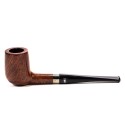Tobacco Pipes with or without filters: pros and cons
RUNNING OUT OF FILTERS? CLICK HERE TO GET THEM AT THE BEST PRICES!
When it comes to tobacco pipes with or without filter, it’s important to understand the main types available: activated charcoal filters and balsa wood filters.
The former were introduced by Vauen, while the latter by Savinelli.
Both types are commonly available in the 9 mm format, but in recent years, Vauen has also offered 6 mm activated charcoal filters.
Activated charcoal filters are particularly popular in Germany, where aromatic tobaccos, rich in chemical additives, are widely used. These filters help tone down the often overpowering flavors typical of such tobaccos.
In Italy, however, filters have never gained much traction.
For many years, Italian tobacco pipe manufacturers did not produce filter-compatible models, but they eventually adapted to meet market demands. Today, many tobacco pipes come with a fitting for a filter or a reducer to narrow the draft hole to 3 mm.
What is a tobacco pipe filter for?
A tobacco pipe filter serves two primary purposes:
1. To reduce smoke intensity: it softens the flavor and aroma of the tobacco, which can sometimes be overly sweet or cloying, a common trait of tobaccos popular in Nordic countries.
2. To ensure a drier smoke: by trapping some of the moisture during smoking.
How long does a tobacco pipe filter last?
The lifespan of a filter depends on the type of tobacco and your smoking habits, but it’s generally recommended to replace it every two or three uses.
What happens if you smoke without a filter?
Smoking without a filter allows you to fully appreciate the complete aromatic profile of the tobacco.
Tobacco pipes with filters typically have a 9 mm chamber to accommodate them, but if you remove the filter, a small expansion chamber is created between the shank and the mouthpiece. This setup, similar to a Reverse Calabash, helps cool the smoke.
However, smoking without a filter can sometimes lead to increased condensation, depending on the type of tobacco pipe used.
Tobacco pipes with filters: pros and cons
Advantages:
- Provides a drier smoke.
- Reduces tobacco intensity, ideal for those who prefer milder flavors.
- Slows down tobacco pipe fouling, making it convenient for smokers who don’t clean their pipes regularly.
Disadvantages:
- The reduced intensity may not appeal to those who prefer a fuller smoking experience.
Tobacco pipes without filters: pros and cons
Fabio personally prefers tobacco pipes without filters, which are a hallmark of Italian tradition. Here are the main reasons:
Advantages:
- Allows full appreciation of natural blends and English Mixtures in their entirety. In Italy, these tobaccos are far more popular than aromatics.
- Superior aesthetics: Smaller pipes without filters tend to have more harmonious proportions, whereas pipes with filters often have thicker, less elegant shanks.
Disadvantages:
- Smoking without a filter can result in a more intense experience, requiring greater care during use.
How to choose a tobacco pipe filter
There are many options available on the market for both activated charcoal and balsa wood filters. Among the most reputable brands are Vauen, renowned for its high-quality activated charcoal filters, and Savinelli, the go-to brand for exceptional balsa wood filters.
Both brands offer filters in 6 mm and 9 mm formats.
How to change a tobacco pipe filter
Replacing a tobacco pipe filter is very simple, you just need to remove the tobacco pipe's mouthpiece, insert the filter into the designated slot and reattach the mouthpiece.
If your tobacco pipe has a reducer for 9 mm filters, simply remove it before inserting the filter.








